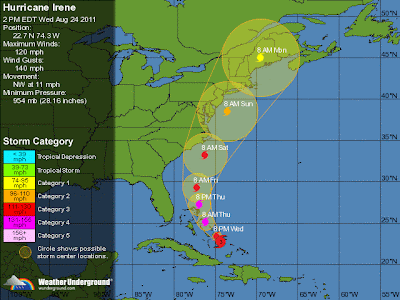The new predicted track is in and it's the "worse." (See previous post.) Though Hurricane Irene failed to achieve category 4, after battering the Bahamas it has reconstituted as a strong category 3 and is headed up the eastern seaboard of the U.S.
Hardly a blip on the news last night when I posted, this is now the dominant story. Why? Well, the media centers of New York City and DC are threatened, but it's otherwise warranted as well: this storm could affect areas where 55 million Americans live, including 20 million in the New York City area, and 2 million on the New York/New Jersey shoreline alone. In Manhattan, Ground Zero (the World Trade Center site) is particularly vulnerable.
Six states on or near the eastern coast have declared emergencies. Mayor Bloomberg of NYC has ordered the evacuations of hospitals and nursing homes in low-lying areas, and will consider larger evacuation by Friday morning. He suggests the city's subway system, pretty much a lifeline for New York, may
shut down on Saturday.
As of Thursday afternoon, Irene was an "unusually large" storm, spread 250 miles in every direction. As it moves up the U.S. coast it will cross the warmest waters ever recorded off New York and New Jersey.
"Irene's middle name is Global Warming," said Bill McKibben on MSNBC.
Right now the storm is tracking to begin affecting North Carolina on Friday, as a category 3 hurricane. It would reach Virginia and Washington late Friday and Saturday, possibly weakening to category 2. Then it moves up the coast from Saturday to Sunday and Monday, expected to weaken as it goes but still a category 1 when it reaches New York/New Jersey. But even if it is down to tropical storm force winds, the damage could still be considerable.
The population areas it could affect dramatically include
Washington, Philadelphia, New York City and Long Island, and possibly Boston. Storm surges could flood New York subways and airports. Heavy rain and wind are also expected with this storm. "We could be looking at mandatory evacuations up and down the East Coast," said a Weather Channel reporter. Already, commercial air flights and scheduled trains are being cancelled. The scheduled dedication of the Martin Luther King memorial in Washington has already been
cancelled as well.
But amidst what could be a catastrophic storm, affecting these areas for days and weeks, GOPer House majority leader Eric Cant's office is insisting that
no federal emergency aid be rendered unless offset by budget cuts.



















